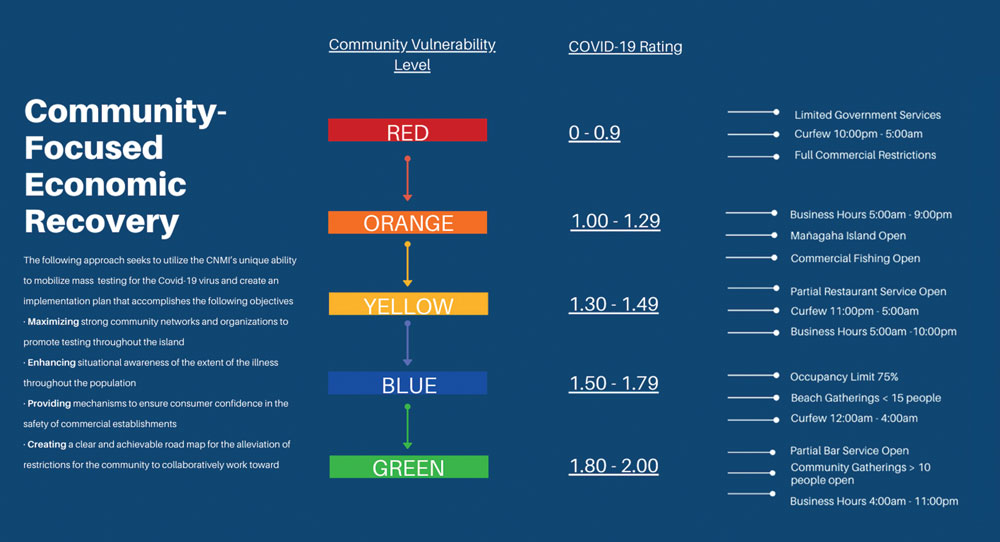Restrictions eased
Curfew: 11pm to 5am
Gov. Ralph DLG Torres is officially easing the restrictions on businesses and curfew, following amendments to the COVID-19 emergency directives that have been in place since January to stop the spread of the coronavirus pandemic in the CNMI. Under a new color-coded community vulnerability scale, the CNMI is currently at Yellow, two steps down from the highest Red level.
With mass testing in place, which provides critical data on the state of coronavirus infection on island, and the quick implementation and community adoption of the mitigation measures set by the government, the CNMI has flattened the peak of the curve, which was forecasted to happen this May.
For a safe and cautious transition, Torres’ economic recovery team created a four-colored framework to guide the resumption of domestic activity in the CNMI, based on the mass testing, which the government refers to as a community-based testing initiative. This graduated cumulative testing brackets—from the safest, which is Green, to the worst, which is Red—allow for the alleviation of restrictions set under the directives. It goes from Green, to Blue, to Yellow, to Orange, and finally Red, and becomes effective starting today, May 26, 2020. These restrictions can be scaled up or back, based on the rate of the community’s vulnerability over a period of 30 days, and calculated daily by the Commonwealth Healthcare Corp. and the COVID-19 Task Force.
Based on the recent testing data collected by the CHCC and the COVID-19 Task Force, the CNMI’s is now at level Yellow.
“We continue to urge individuals to practice good hygiene, exercise social distancing at all times when not at home, and to wear face masks when in public, especially when feeling ill. Additionally, we encourage individuals and businesses to seek guidance regarding the implemented social distancing requirements from CHCC and/or the COVID-19 Task Force,” said an Office of the Governor statement yesterday.
The community is also encouraged to report any non-compliance to CHCC and/or the COVID-19 Task Force.
These amendments take effect today, May 26, 2020.
Social distancing and curfew
While gatherings of more than 10 people in the same room or single space, at the same time, remain prohibited, church services can now start, provided that the attendance be limited to 25% of the allowed occupancy of the place of worship, and that social distancing and sanitation guidelines be strictly observed.
Non-contact recreational activities, such as exercise in gyms, are now permitted, also under strict social distancing and sanitation guidelines.
Before resuming operations, guidance on mandatory social distancing and sanitation implementation must be sought from CHCC, and must be implemented throughout the continued State of Significant Emergency and Public Health Emergency.
Everyone should continue to practice social distancing, and are strongly encouraged to wear face masks when outside the home.
Curfew hours are now from 11pm to 5am.
Business operations
Businesses that have facilities open to the general public can now open from 5am to 9pm, and may operate beyond these times, but not be open to the general public. Drop off/pick up and delivery services are not allowed past curfew.
Social distancing guidelines must be implemented, including the posting of “one-way” flow signs for entrance and exit; crowd control; availability of hand sanitizer station on entry and on exit; provision of protective barriers between worker and customer; and ensuring there are visible customer lineup markers that are 6 feet apart leading to the cashier counter.
Businesses must regularly and frequently clean all surfaces; sanitize main entrance door handles; sanitize handles of shopping baskets and shopping carts after each use; sanitize handles for chill boxes, cooler, and freezers.
Businesses shall also limit occupancy to 50% in accordance with supplemental regulatory guidance set by the CHCC and the Department of Public Works’ Building Code.
Businesses unable to properly implement the guidelines should remain closed until it can and does in fact, properly implement the guidelines.
CHCC, public and private health clinics, dental clinics, and pharmacies may set hours that, in their judgment, best deal with the COVID-19 threat. These businesses are encouraged to follow best social distancing practices for health facilities.
Gas stations may be open during business hours.
First-time violators among businesses will be closed immediately for a month; second-time violators will be immediately closed for six months; and third-time or more offense violators will be immediately closed for a year.
Restaurants
Dine-ins are now allowed under strict social distancing parameters, and at 25% of a restaurant’s original permitted occupancy limit.
All other businesses that offer food or beverages, such as bars, must remain closed for on-premises consumption. In-house delivery, third-party delivery, drive through, and curb-side pick-up are allowed. Hotel restaurants may continue to provide room service and take-out. Catering services may still continue.
Establishments offering food or beverages for take-out, including food trucks, must ensure that patrons maintain adequate social distancing.
Food establishments are also encouraged to use outdoor dining space wherever possible.
Parks and recreation
All public parks, including the Grotto, remain closed to the public. Only Mañagaha Island is open now to the public, so long as social distancing requirements are implemented for both transport vessels and on-island activities. Transport vessels must do constant and consistent disinfection.
Only exercise and wellness, both physical and mental, and shoreline subsistence fishing and commercial fishing, are allowed in public beaches and pathways, subject to strict social distancing.
All businesses engaged in gaming, including the casino, video poker establishments, and e-gaming facilities, as well as engaged in recreational and amusement type activities, remain closed to the public.
Tourism industry
Hotels, tour operators and tourism industry stakeholders may begin preparations for thermal monitoring and establish internal Standard Operating Procedures for mitigating risk in preparation for tourist arrivals
Preparations among tourism operators may continue in anticipation of the resumption of flights and guidance should be sought on the steps necessary to resume international flights.

























